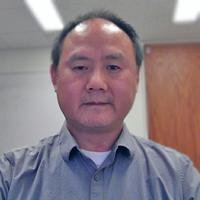High Fidelity Neutronics Simulation and Thermal-hydraulics Coupling
| Event Date: | January 24, 2018 |
|---|---|
| Speaker: | Yunlin Xu, Ph.D. |
| Speaker Affiliation: | Argonne National Laboratory and
University of Michigan |
| Time: | 3:30 p.m. |
| Location: | PHYS112 |
| Priority: | Yes |
| School or Program: | Nuclear Engineering |
| College Calendar: | Hide |
Abstract
Three-dimensional, full core modeling with pin-resolved detail has become the state of the art in computational simulation for nuclear reactors. The 2D/1D approach is used to reduce the computational burden of the direct 3D calculation of the neutron transport equation. The radial 2D solver utilizes the 2D Method of Characteristics (MOC) solution, and the 1D solver utilizes a 1D nodal solution. The 2D and 1D solutions are coupled using transverse leakages. The 2D-1D method is extended to time-dependent transport applications using a Transient Multi-Level (TML) method. The TML method significantly reduces the number of high order transport calculations, and the Predictor-Corrector Quasi-Static Method (PCQM) iteration scheme couples the 3D-Transport/3D-CMFD level and the 3D-CMFD/EPKE level. With TML method, it is possible to simulate rapid transient of full-size PWR on thousands of computer cores and within hours.
In nuclear reactor simulation, neutronics and thermal-hydraulics are tightly coupled. NRC has started to develop coupled thermal-hydraulics code TRACE and 3D neutron spatial kinetics from 1998, and PARCS is later integrated into TRACE. The coupled code system has been applied widely to nuclear reactor safety analysis. We have also applied the code system to BWR stability analysis. By carefully selecting axial cell lengths of TRACE channels, the numerical diffusion with thermal hydraulics system code is minimized and the prediction of BWR stability are well agreed with the experiments of Ringhals and Oskarshamn power planes.
Bio
Dr. Yunlin Xu is a researcher at the nuclear division of Argonne National Laboratory and adjunct associate professor of Nuclear Engineering and Radiological Sciences at the University of Michigan. He had received his Ph.D. in Nuclear Engineering from Purdue University in 2004. Before came to Purdue, He was an associate professor at Tsinghua University from 1991 to 1999 and was in charge of nuclear reactor physics designs of the nuclear heating reactor and 10MW high-temperature gas-cooled reactor which was successfully built and operated in 2000. After Graduated from Purdue, Dr. Xu had worked at Purdue as visiting assistant professor and then worked on current position since 2008. Dr. Xu is the principal developer of US. NRC code PARCS, and is also leading the 3D neutron transport code MPACT for CASL project. Dr. Xu’s research is focused on the areas of nuclear reactor physics design and safety analysis, Neutron kinetics simulation, multi-physics coupling, and large linear and non-linear system solution methods.
2018-01-24 15:30:00 2018-01-24 16:30:00 America/Indiana/Indianapolis High Fidelity Neutronics Simulation and Thermal-hydraulics Coupling PHYS112

